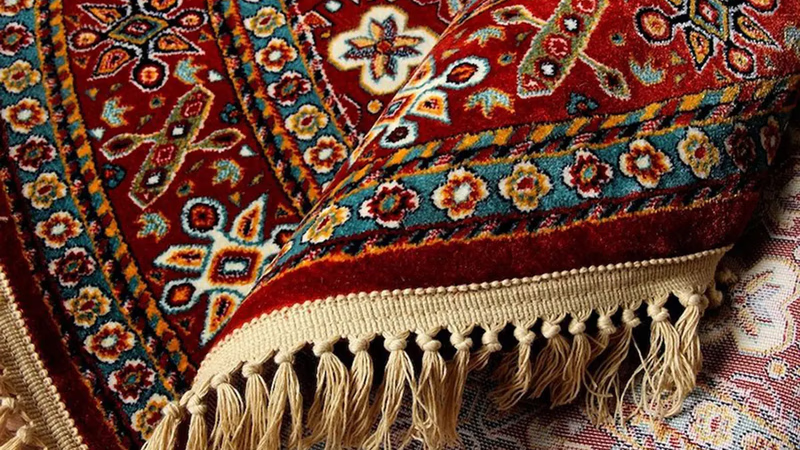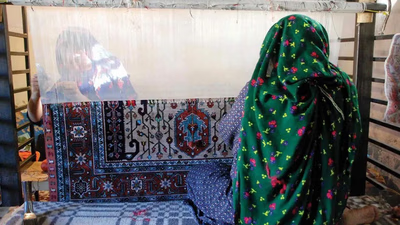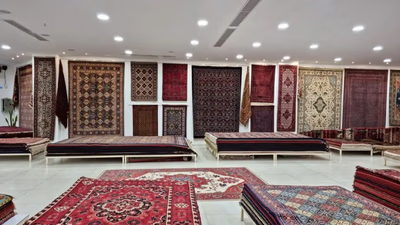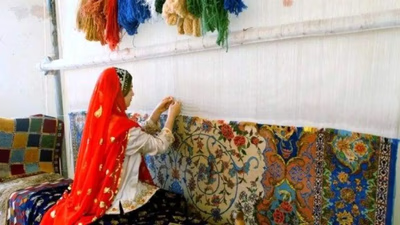
Handwoven carpets showcase unique designs in the Middle East market.
The supply and demand market of handmade carpets is a global market that operates all over the world. The demand for buying handwoven carpets is affected by several factors. Market factors can also affect the demand for handwoven carpets. Factors such as economic prosperity, price changes, sanctions and trade policies affect the consumer market and demand. The supply and demand for buying and selling handwoven carpets is influenced by a combination of cultural factors, design and quality, environment, price and market factors. All these factors make buyers decide to buy or not to buy handwoven carpets.
Iran is known as one of the most important countries producing hand-woven carpets and it is sold inside Iran and also as an exporter to other countries. The American market plays an important role in buying and selling handwoven carpets. The demand of different strata of the American society as well as the existence of collectors and wealthy private collections is one of the most important demand factors in this market. Countries such as Germany, France, England and Italy are also strong markets for buying and selling handwoven carpets. The demand from art and interior design enthusiasts in these countries is very high. As one of the largest producers of handwoven carpets, China also plays an important role in the supply and demand market. Also, there is a high demand for handwoven carpets within China.
In countries such as Iran, Turkey, Afghanistan and India, local producers are among the largest sellers of handwoven carpets. They supply their carpets in domestic markets as well as for export. International carpet auctions and exhibitions play an important role in the supply and demand of handwoven carpets. For example, the international carpet weaving exhibition in Hamadan in Iran is one of the most important events in the carpet weaving industry. Stores and online platforms also play an important role as supply and demand channels for handwoven carpets in the world. Reputable stores in famous carpet-weaving cities and regions, such as Hamedan and Isfahan in Iran, are the main places to buy hand-woven carpets. Also, the existence of stores and galleries in other countries is also important for the supply of authentic handwoven carpets.
Buying from reliable and reputable sellers, such as reputable stores or well-known manufacturers, gives you more confidence about the authenticity of the carpet. Some reputable sellers offer certificates of authenticity for their rugs. These certificates include information about the type of carpet, source of production, materials used and other details related to the carpet. Studying the details of the texture and method of weaving the carpet can help you to recognize the authenticity of the carpet. Some of the details you might check include fine and coarse adjustments in texture, type of fabric used, and artistic mapping.
Handwoven carpet is an ancient art and craft that has a history in many cultures and civilizations. As a symbol of the history and culture of a region or country, the carpet provides great appeal to buyers. Interest in original art and design, cultural heritage and connection with the past can be important factors in the demand of buyers. Handwoven carpet is considered as an element of interior decoration. The designs, patterns and unique colors of the carpets add beauty and elegance to the interior. Buyers who are looking to create a unique and artistic atmosphere in their home or workplace are interested in hand-woven carpets.
The materials used in a handmade carpet, such as wool, silk and other natural threads, affect its quality and durability. Buyers are looking for high-quality carpets and high-quality raw materials to achieve a long life and more added value for their purchase. Various designs and patterns of handwoven carpets play an important role in demand. Buyers are looking for carpets that have special and unique patterns and designs. Traditional patterns, flowers and vases, geometric designs or even modern designs can contribute to the demand for handwoven rugs.
Greater awareness of environmental and sustainability issues has made many buyers look for products that are produced using natural materials and have the least possible impact on the environment. Handwoven carpet, as a natural and handmade product, satisfies these needs, and some buyers are looking for carpets that are completely compatible with the environment. Price is one of the main factors of demand for buying handwoven carpets. The price that buyers are willing to pay for a carpet depends on various variables, including the quality, size, design, and materials used in the carpet. In some cases, buyers are willing to pay more for a high-quality rug with a unique design, while others are looking for value-for-money rugs.
-

The value of Middle Eastern handwoven carpets in international trade is influenced by various factors, including quality, design, size, materials, and production location. These carpets are often seen as cultural symbols, which can enhance their market value. Notably, Iranian carpets are highly regarded for their intricate designs and craftsmanship, while Turkish carpets are celebrated for their unique patterns and high-quality materials. Arabic carpets from the Persian Gulf region are recognized for their traditional designs and vibrant colors. Afghan carpets also hold significant value due to their diverse designs and high-quality wool. The price range for these carpets can vary widely, with some fetching millions of dollars as they are considered works of art. Economic conditions, demand and supply dynamics, cultural significance, and market trends all play crucial roles in determining the value of these rugs in global markets. Accurate valuation requires ongoing analysis of these factors to adapt to changing market conditions.
-

Carpets and rugs, while both classified as carpets, differ significantly in their preparation, design, and intended use. Carpets are typically made from materials such as cotton, wool, silk, or synthetic fibers and are characterized by a compact texture and high density. They are primarily used indoors for decorative purposes. In contrast, rugs have a more open texture and are often utilized in outdoor settings. The designs of carpets tend to be intricate and diverse, featuring floral patterns or geometric shapes that reflect regional cultures. Rugs usually exhibit simpler geometric designs. Both carpets and rugs are considered handicrafts that require artistic skills for their production. They embody cultural heritage through their unique motifs and materials sourced from local environments.
The marketing value of these items is significant; they serve as decorative pieces in homes and hotels or as souvenirs. Wool is a primary raw material for both carpets and rugs, with variations in the use of industrial threads for added durability. The dyeing process can involve natural or artificial colors depending on the method used. Overall, the craftsmanship involved in creating carpets and rugs highlights their importance as cultural artifacts.
-

Carpet weaving is a significant cultural art form that preserves national identity and heritage. This traditional craft, recognized for its intricate designs and durability, has been passed down through generations. Each handwoven carpet reflects the unique skills of the weaver, showcasing artistic motifs and stories that embody cultural values. The process involves using simple tools and natural materials like wool and silk, requiring patience and precision. Handwoven carpets are not only valued for their aesthetic appeal but also for their economic significance in the arts and crafts market. They are often considered one-of-a-kind pieces due to their craftsmanship, making them highly sought after by collectors and enthusiasts alike. The art of carpet weaving continues to thrive across various cultures, adapting techniques while maintaining its traditional roots.
-

The global market for handwoven carpets is influenced by various factors affecting supply and demand. Economic conditions, price fluctuations, trade policies, and cultural preferences play significant roles in shaping consumer behavior. Countries like Iran, China, Turkey, Afghanistan, and India are key producers and exporters of these carpets. The American market is particularly important due to its diverse consumer base, including collectors and art enthusiasts. European countries such as Germany, France, England, and Italy also exhibit high demand driven by interior design trends. International exhibitions and auctions are crucial for connecting buyers with authentic products. Reputable sellers provide certificates of authenticity to assure buyers of quality. The appeal of handwoven carpets lies in their cultural significance and artistic value, making them desirable for interior decoration.
Buyers prioritize high-quality materials like wool and silk while seeking unique designs that reflect personal style. Environmental sustainability has become a growing concern among consumers who prefer natural materials with minimal ecological impact. Price remains a critical factor; buyers" willingness to pay varies based on quality, size, design complexity, and material used. "
-

Verifying the authenticity of handwoven carpets is crucial due to their historical, artistic, and economic significance. Each region has unique patterns and designs that can help identify the carpet"s origin. Authentic carpets often feature natural colors that remain unchanged over time, and the materials used—such as wool and silk—are essential indicators of authenticity. Weaving techniques also vary by region, with specific methods, knot types, and densities providing clues to a carpet"s legitimacy. Notable tribes may include unique markings that further confirm authenticity. Consulting experts or reliable sellers is recommended for potential buyers to ensure they acquire genuine pieces. For instance, Hamadan carpets are recognized for their geometric patterns, while Qashqai carpets showcase intricate floral designs. Kashan carpets are distinguished by their diverse patterns and specific markings, whereas Isfahan carpets are celebrated for their artistic detail.
Ultimately, purchasing from reputable sources and seeking expert advice can significantly aid in verifying a carpet"s authenticity. "
-

Hand-woven carpets have a rich history spanning thousands of years, with significant cultural and artistic importance across various regions. The craft is particularly prominent in Iran, where it has evolved through cultural, social, and political influences. Evidence of carpet weaving dates back to ancient civilizations in Central Asia, Turkey, Afghanistan, India, and Europe. Each region has developed unique patterns and techniques that reflect its cultural identity. The art form not only serves as a decorative element but also as a vital industry that provides income and fosters cultural exchange. Notable historical examples include the Pazyryk Carpet from the Achaemenid period, discovered in Siberia, which showcases intricate floral and geometric designs. Despite the scarcity of ancient carpets due to time"s passage, ongoing archaeological research continues to uncover significant artifacts that highlight the craft"s historical depth. Today, hand-weaving remains a vibrant practice worldwide as artisans blend traditional methods with modern innovations to create unique pieces while striving to preserve this valuable art form.






